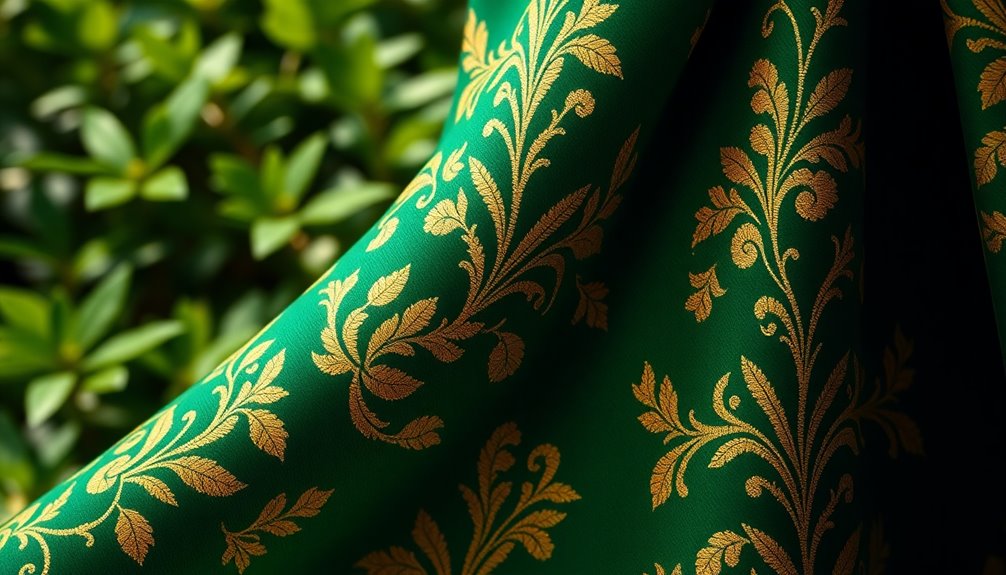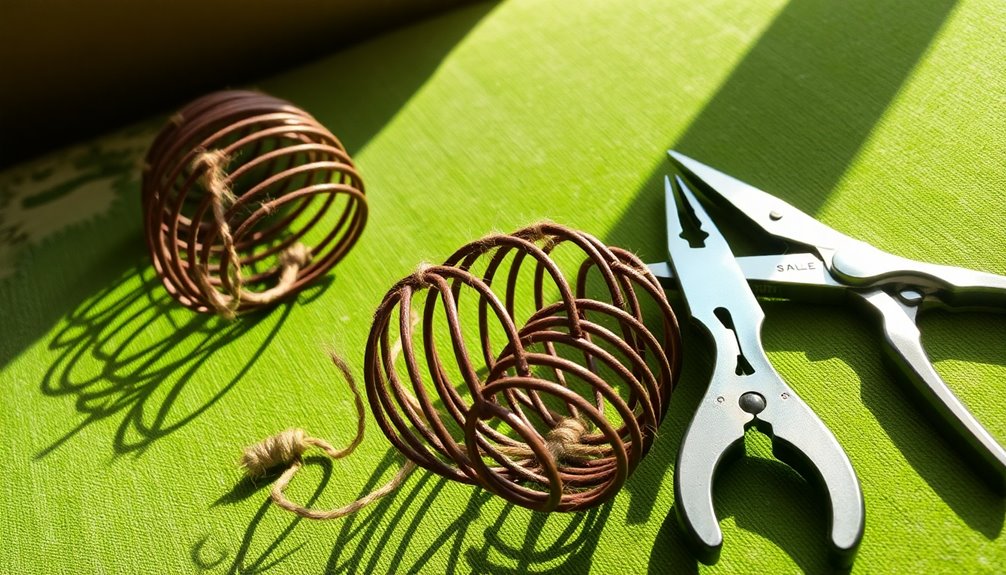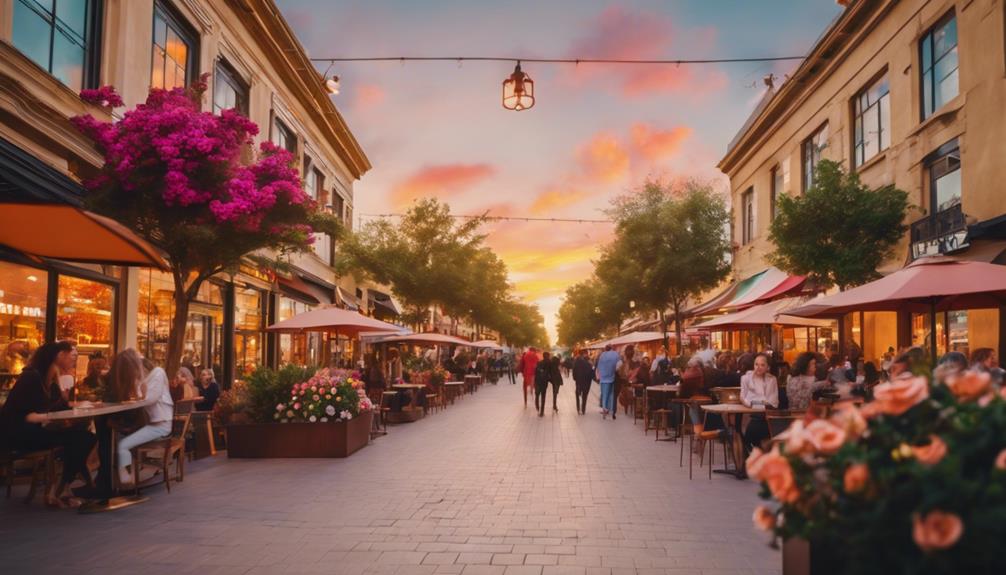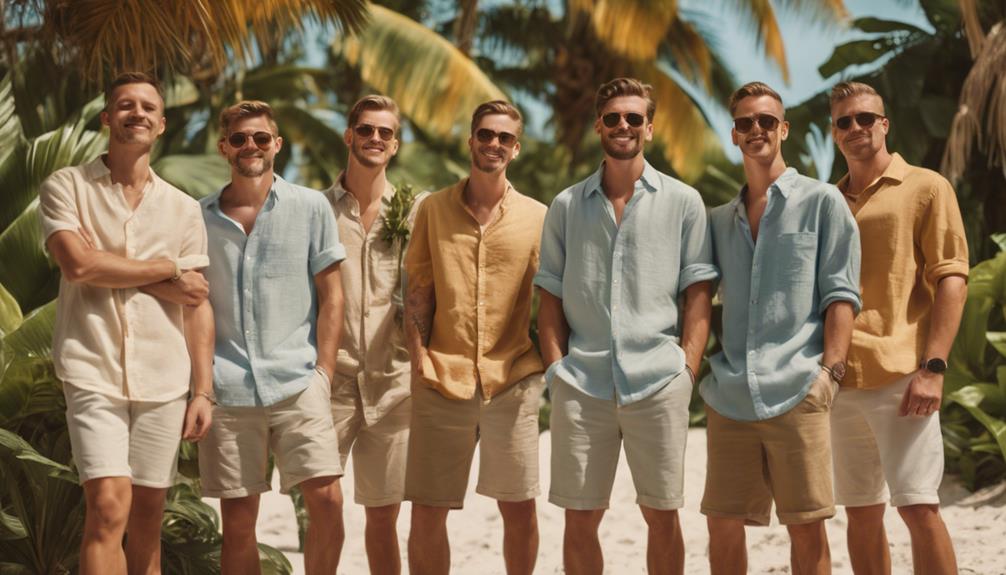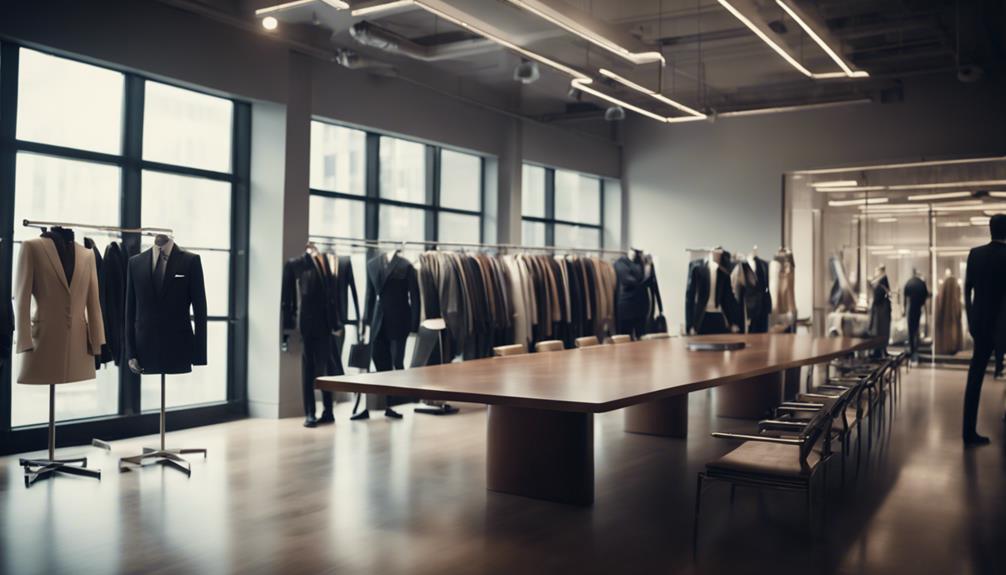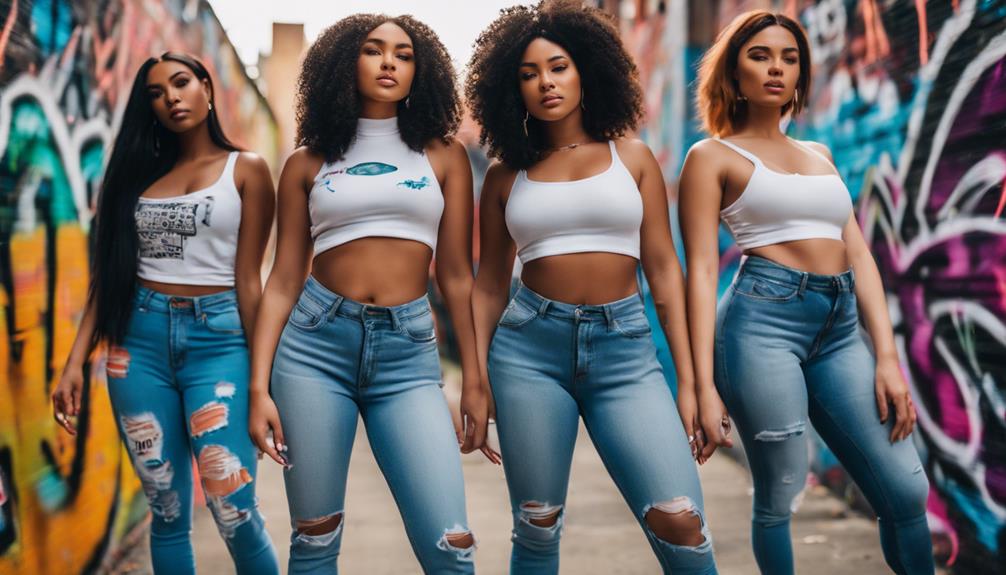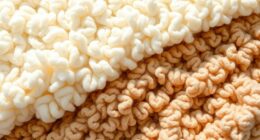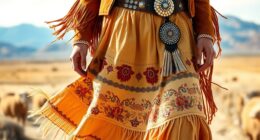Sustainable velvet and brocade are revolutionizing modern textiles by merging eco-friendly methods with classic Renaissance elegance. Velvet crafted from organic cotton and recycled fibers minimizes waste and chemical usage, while brocade made from sustainable materials like hemp and organic silk reduces environmental impact. Both fabrics utilize innovative, water-efficient production techniques that lower pollution. As you explore these luxurious yet responsible choices, you'll find a variety of applications, from exquisite evening wear to stunning home décor. There's a lot more to discover about how sustainable practices are shaping the future of fashion and textiles.
Key Takeaways
- Sustainable velvet is made from eco-friendly materials like organic cotton and recycled fibers, minimizing environmental impact during production.
- Brocade fabric's sustainable options include organic silk and hemp, utilizing waterless dyeing processes to conserve resources.
- Both sustainable velvet and brocade are biodegradable, reducing landfill waste and supporting a circular economy.
- Eco-friendly velvet and brocade often feature certifications like Oeko-Tex and GRS, ensuring compliance with health and sustainability standards.
- The historical significance of brocade, originally a symbol of wealth, is now paired with modern eco-conscious practices in its production.
Overview of Sustainable Fabrics
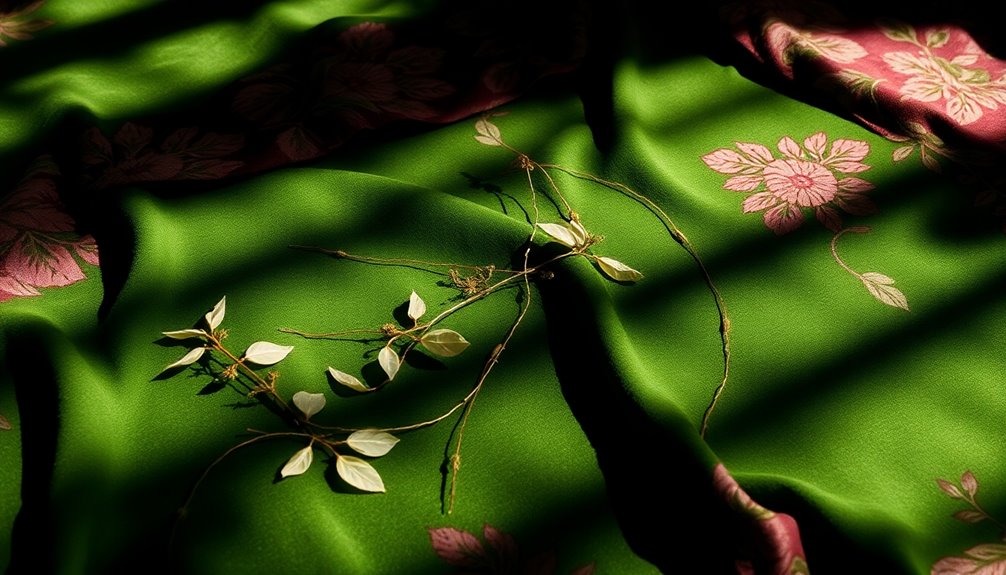
Sustainable fabrics are gaining traction as consumers become more environmentally conscious. You might be surprised to learn that options like organic cotton, hemp, and bamboo are sourced with minimal chemicals, making them a healthier choice for the planet. These natural fibers require less water than conventional cotton, with bamboo and organic linen leading the way in water efficiency. Sustainable textiles help mitigate climate change effects, with organic farming practices reducing water use and promoting healthier ecosystems. Additionally, hemp environmental benefits extend beyond its low water requirements; this remarkable plant grows rapidly and can thrive in nutrient-poor soil, reducing the need for harmful fertilizers. By choosing sustainable fabrics like hemp, consumers can support a more circular economy and reduce their ecological footprint. Embracing these materials not only fosters healthier ecosystems but also encourages ethical practices within the fashion industry, paving the way for a more sustainable future.
Sustainable farming practices ensure that these materials are grown without harmful pesticides and synthetic fertilizers, promoting soil health. For instance, hemp returns 60-70% of nutrients back to the soil, enhancing its sustainability.
Additionally, fabrics like lyocell come from wood pulp sourced from sustainably managed forests, further supporting eco-friendly production.
Biodegradability is another key feature of sustainable fabrics. Organic linen, wool, and lyocell naturally break down, reducing textile waste in landfills. By avoiding harmful chemicals, organic cotton and hemp also aid in natural decomposition.
Recycled materials, such as recycled cotton and polyester, divert waste from landfills and diminish the need for virgin resources. Together, these elements create a more responsible and eco-friendly textile industry, allowing you to make choices that align with your values.
What Is Sustainable Velvet?
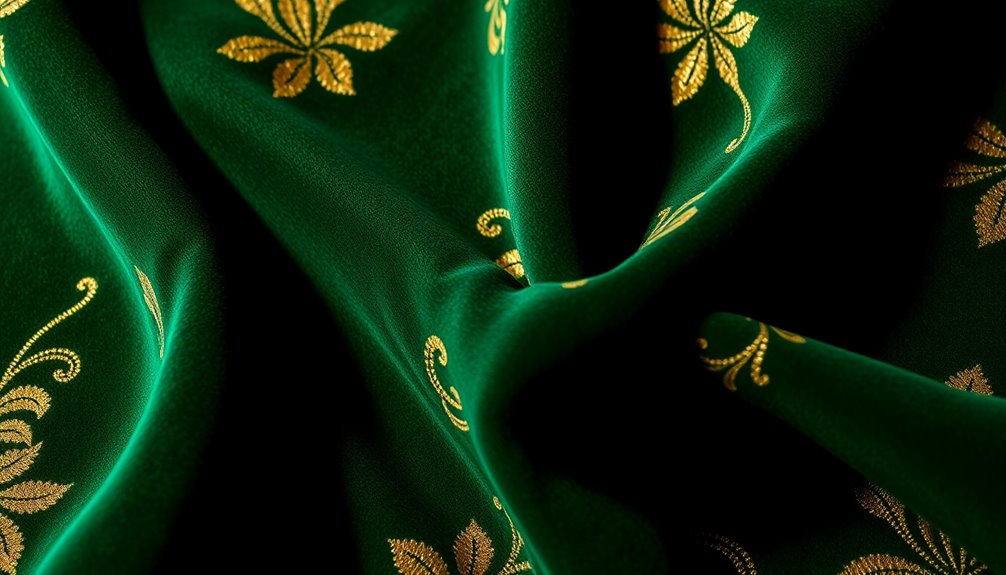
Sustainable Velvet and Brocade: Eco-Friendly Renaissance Fabrics
What Is Sustainable Velvet?
Velvet, known for its sumptuous texture and elegance, is evolving into a more eco-friendly option with sustainable practices. Sustainable velvet is crafted using materials and methods that prioritize environmental health.
For instance, organic cotton, grown without synthetic pesticides and fertilizers, significantly reduces your environmental impact. You might also find sustainable velvet made from recycled fibers, which helps minimize waste by repurposing pre- or post-consumer materials.
Additionally, bamboo is a popular choice because it's a fast-growing plant requiring less water and pesticides. Lyocell, derived from sustainably sourced wood pulp, further reduces the ecological footprint. Moreover, the use of eco-friendly materials in velvet production plays a crucial role in promoting sustainability.
Production practices enhance sustainability as well; manufacturers often employ energy-efficient processes and non-toxic dyes that protect both workers and the environment.
Composition of Sustainable Velvet
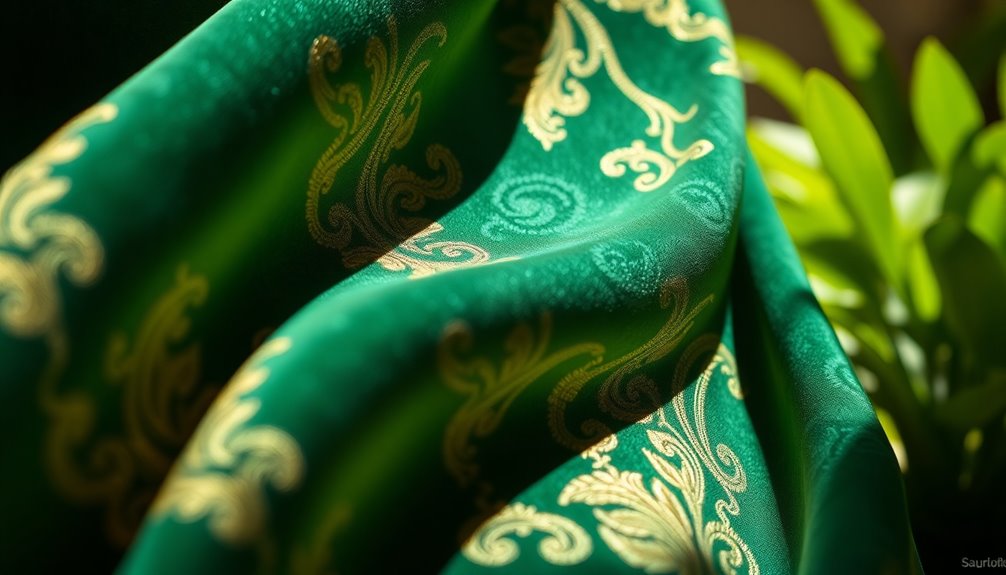
The composition of eco-friendly velvet blends innovative materials and responsible production methods to create a luxurious textile with a lower environmental impact. One of the primary materials used is organic cotton, grown without synthetic pesticides or fertilizers, which supports sustainable agriculture.
Recycled fibers, derived from post-consumer plastic bottles or textile waste, further reduce the need for virgin resources. Bamboo is also popular, as it requires less water and pesticides compared to traditional cotton.
Sustainable velvet often incorporates Better Cotton Initiative (BCI) cotton, which minimizes chemical use in production. Upcycled materials give new life to existing velvet items, reducing landfill waste.
The production processes prioritize energy efficiency, using methods that lower carbon emissions and conserve water—recycled velvet can cut water usage by up to 80%. Non-toxic dyes and finishes ensure the fabric is safe for both people and the environment.
Additionally, certifications like Oeko-Tex 100 and Global Recycled Standard (GRS) guarantee that the velvet meets health and sustainability standards. Furthermore, the commitment to ethical sourcing practices ensures that sustainable velvet aligns with eco-conscious values.
With these materials and methods, sustainable velvet not only exudes luxury but also aligns with eco-conscious values.
Environmental Benefits of Velvet
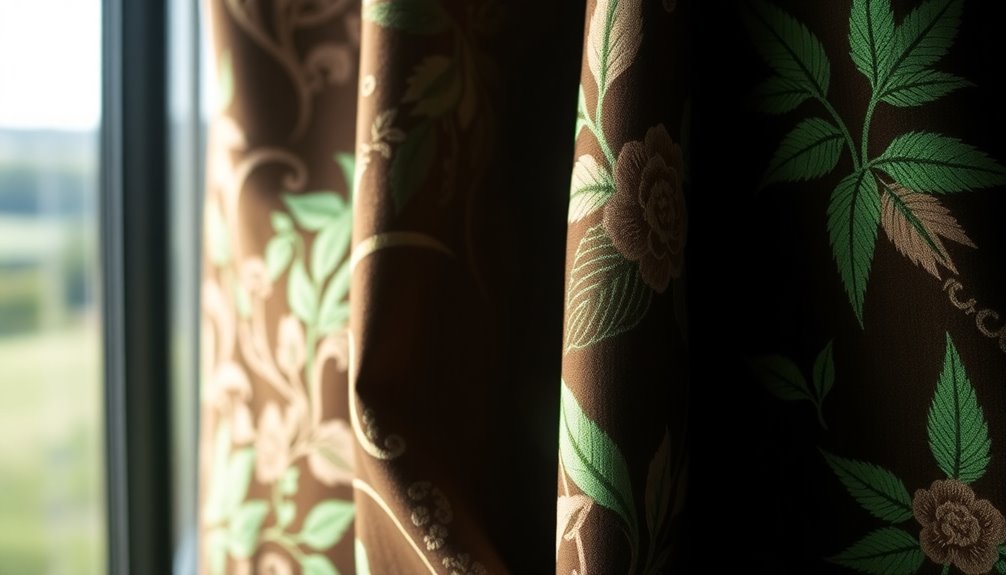
Among the various textiles, velvet stands out for its remarkable environmental benefits, particularly when produced with eco-friendly materials and processes. When you choose velvet made from natural fibers like silk or cotton, you're opting for a biodegradable option that decomposes without contributing to landfill waste or pollution. This choice supports a circular economy by reducing reliance on non-renewable resources. Furthermore, velvet fabric's sustainability is influenced by the choice of fiber and production methods used, making it crucial to select responsibly sourced materials. Additionally, the raw food diet emphasizes whole, unprocessed foods, which mirrors the eco-conscious approach to selecting sustainable fabrics.
Moreover, innovative manufacturing techniques significantly reduce water consumption. By implementing advanced dyeing methods and recycling systems, the water footprint of velvet production shrinks, helping to alleviate water scarcity issues. You'll appreciate the shift towards water-conscious practices that protect vital water resources.
Additionally, natural fiber-based velvets require fewer chemicals than synthetic alternatives, which often involve harmful treatments. By prioritizing chemical-free processes, you contribute to decreasing air and water pollution.
Sustainable sourcing further enhances velvet's eco-friendliness. Utilizing materials like recycled cotton or sustainably harvested eucalyptus lessens the depletion of non-renewable resources, aligning with broader sustainability goals.
In essence, choosing eco-friendly velvet not only benefits your wardrobe but also supports a healthier planet.
Applications of Sustainable Velvet
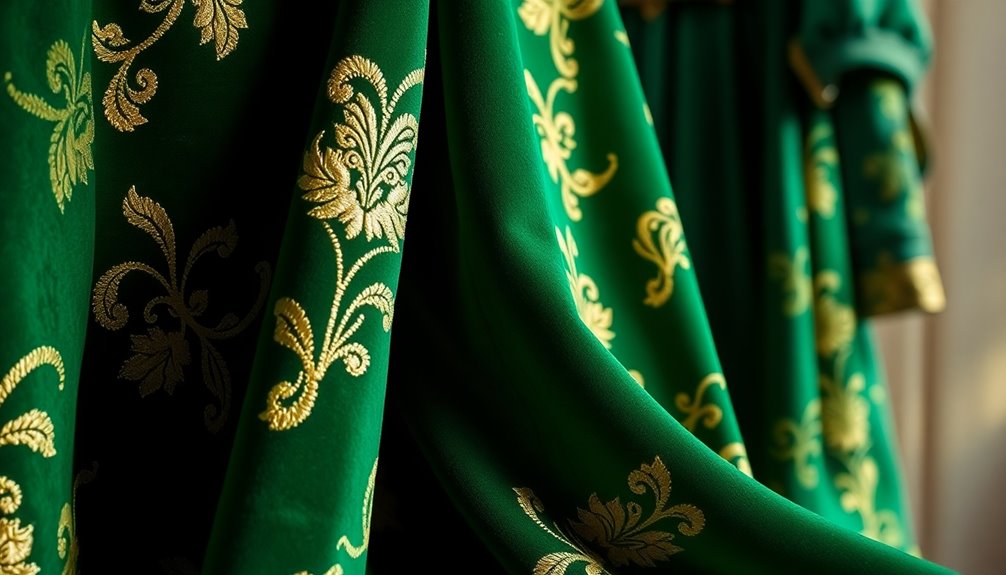
Sustainable velvet finds its way into a variety of fashion applications, making it a versatile choice for eco-conscious consumers. You can discover this luxurious fabric in everything from clothing to home décor. Brands like Christy Dawn and ARMEDANGELS prioritize sustainable materials, using organic cotton, bamboo, and recycled fibers to create stunning garments. They often incorporate eco-friendly options like TENCEL™ Modal or Lyocell, sourced from sustainably harvested beech trees. Additionally, diversification of retirement portfolio is essential in volatile economies, just as sustainable fabric choices can enhance your wardrobe.
When you choose sustainable velvet, you support brands committed to ethical practices and reducing emissions. Look for certifications like GOTS for organic cotton or GRS for recycled fabrics to ensure your purchases align with your values. You might also consider shopping secondhand to minimize waste and extend the life of existing velvet items. Additionally, many brands engage in life-cycle assessment to evaluate the environmental impact of their products.
Sustainable velvet's innovative production methods, such as upcycling and using non-toxic dyes, further enhance its appeal. By selecting high-quality, well-made velvet pieces, you help reduce the frequency of replacements while making a positive environmental impact.
Additionally, opting for natural fibers over synthetics keeps your wardrobe both stylish and sustainable, allowing you to enjoy luxury without compromising your principles.
Understanding Brocade Fabric
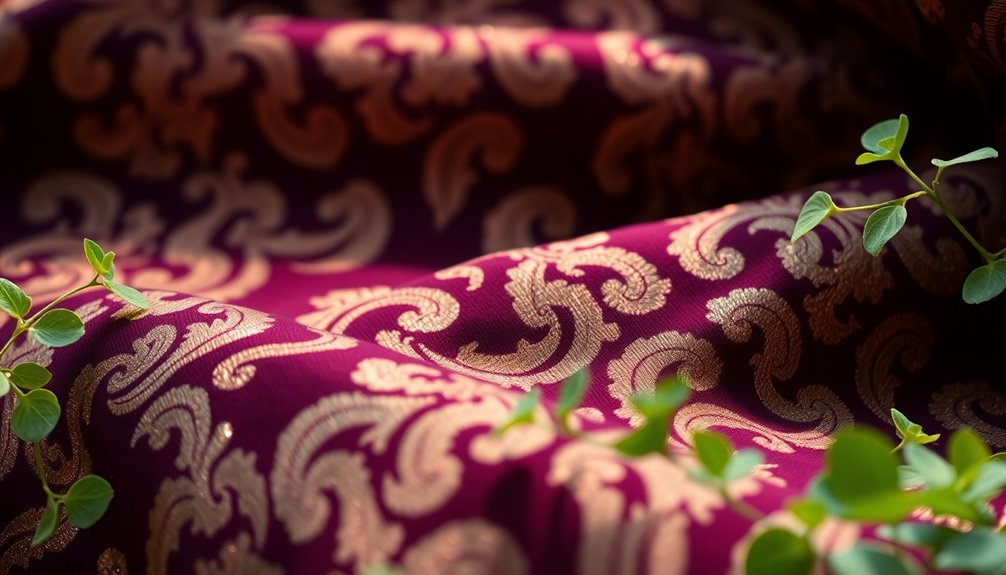
Brocade fabric captivates with its rich texture and intricate designs, making it a favorite choice for those seeking elegance in their wardrobe or home décor. This luxurious material features a dense, woven texture that feels heavy and substantial, thanks to its intricate weave of multiple layers of thread.
The defining characteristic of brocade is its raised patterns, achieved through supplementary weft threads woven into the base fabric, which adds depth and visual interest.
Traditionally crafted from silk, modern brocade can also include cotton, synthetic fibers, or blends, offering versatility in both look and feel. Its shimmering appearance, often enhanced with gold or silver threads, elevates any design.
The use of computerized jacquard looms allows for the creation of complex patterns, ensuring that each piece is unique. Additionally, the weaving process involves warp and weft threads, which contribute to the fabric's luxurious texture.
While brocade boasts durability and strength, it typically requires dry cleaning to maintain its beauty. Its heavy, stiff nature means it's generally wrinkle-resistant.
However, if you're considering brocade for clothing or décor, keep in mind its minimal stretch and potential for pilling over time, depending on the weave and thread count.
Composition of Brocade Fabrics
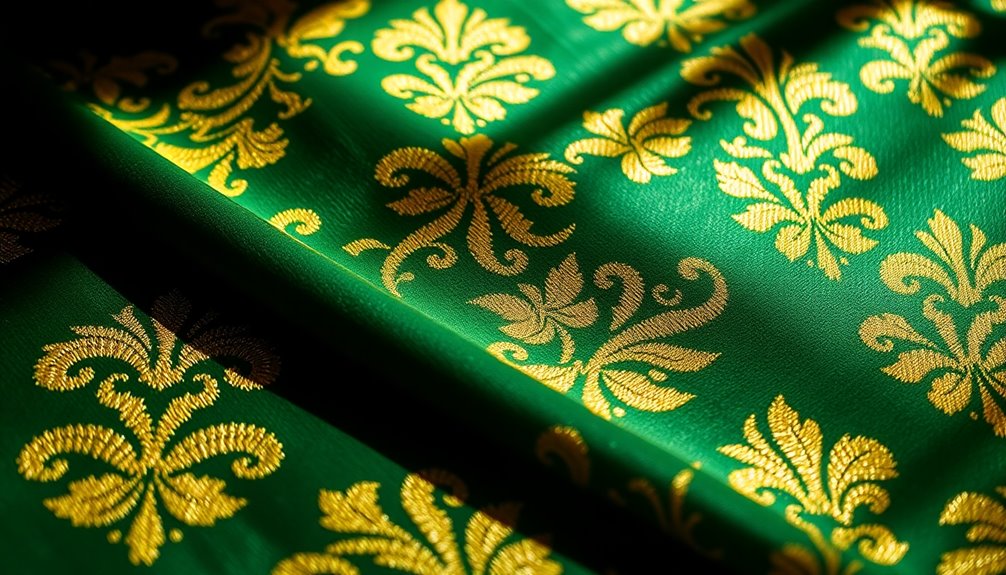
The composition of brocade fabrics plays a crucial role in defining their luxurious appeal and functionality. Traditionally, silk dominates brocade, making up between 80% to 95% of the fabric. This rich material offers unmatched softness and breathability.
To enhance opulence, metallic threads, often in gold or silver, are woven in for striking accents. While silk and metallic threads symbolize wealth in cultures like ancient China and India, secondary fibers such as cotton, linen, or wool can contribute up to 10% for added strength.
In modern brocade, silk-cotton blends are common, with ratios like 50/50 offering a balance of luxury and practicality. Synthetic fibers like polyester or nylon might comprise over 70% of some fabrics, increasing durability and wrinkle resistance. Synthetic fibers are also increasingly used, reflecting a trend towards more affordable production methods.
You may also encounter brocades made from bamboo or recycled materials, reflecting a shift toward eco-consciousness.
Specific types of brocade, such as silk brocade and cotton brocade, cater to different needs, from high-end fashion to casual home decor. The intricate weave, often created on computerized Jacquard looms, adds to the fabric's density and texture, ensuring a luxurious finish.
Eco-Friendly Features of Brocade
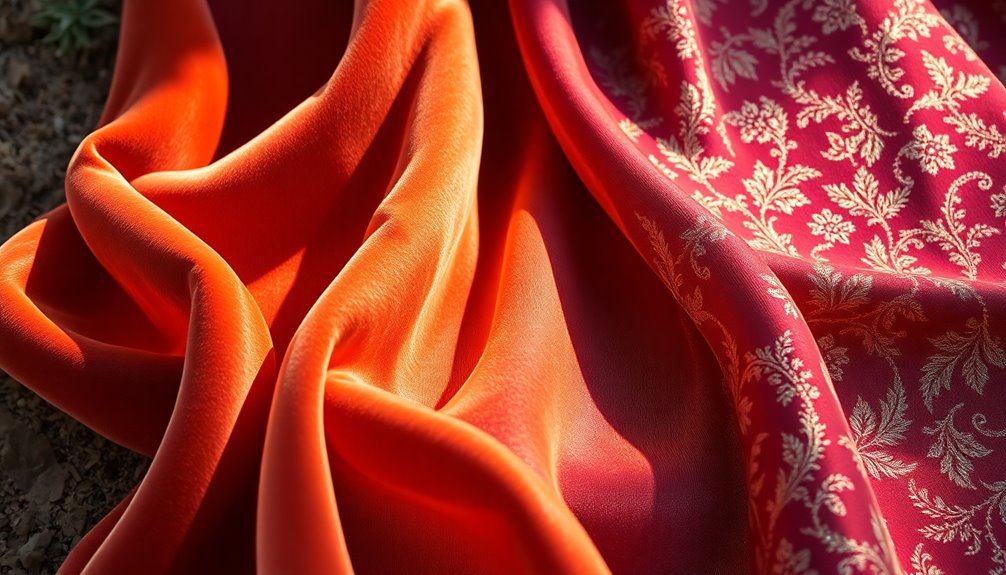
Many modern brocade options are embracing eco-friendly features that benefit both the environment and consumers. You'll find that sustainable fibers, like organic silk and plant-based materials such as hemp and bamboo, significantly lower the environmental impact of brocade production. These fibers often require fewer resources and promote biodiversity, making them a smart choice for eco-conscious shoppers. Additionally, the production of traditional brocade has raised significant concerns regarding its environmental impact, leading to an increased demand for sustainable alternatives.
Innovative production techniques play a crucial role as well. Waterless dyeing processes and digital printing not only conserve water but also minimize chemical waste. Plus, advancements in Jacquard looms enhance efficiency, reducing fabric waste during weaving. By opting for brocade made from recycled synthetic fibers, you're helping divert plastic waste from landfills, as these fabrics are crafted from post-consumer materials like PET bottles.
Natural dyes are another eco-friendly feature, offering a more sustainable alternative to synthetic options. When you choose brocade with certifications like GOTS or Global Recycle Standard, you're ensuring the fabric meets high ecological and social standards. This commitment to sustainability not only supports the planet but also empowers traditional artisans, preserving cultural heritage while promoting responsible practices.
Applications of Brocade Fabrics
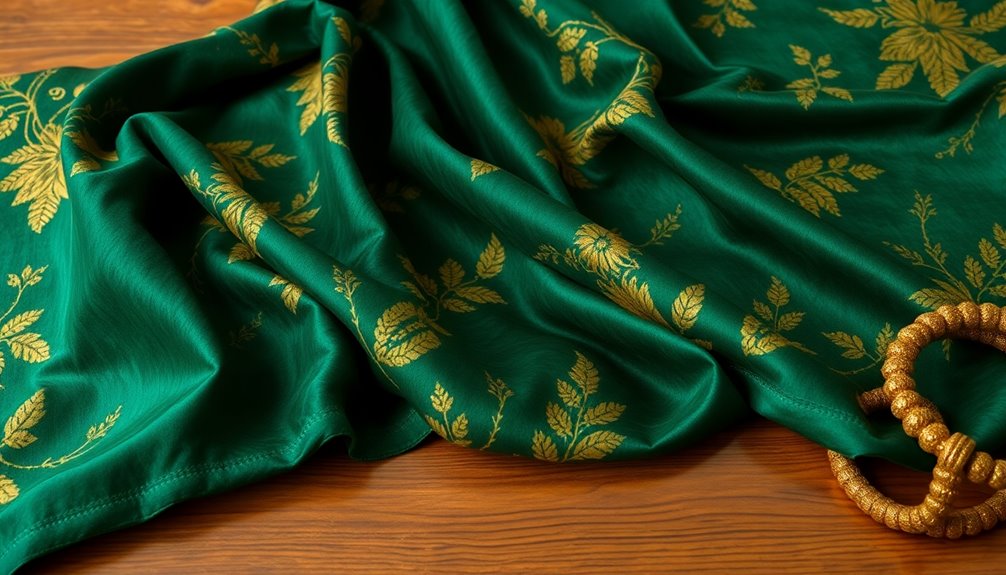
When considering the applications of brocade fabrics, you'll find they offer a unique blend of elegance and versatility. In the realm of clothing and fashion, brocade is often used to create stunning dresses, suits, and jackets, making it a popular choice for evening wear and wedding gowns. Its luxurious texture elevates formal and ceremonial garments, providing a sophisticated touch to traditional attire.
In home decor, brocade shines as well. You can use it for draperies, tablecloths, and upholstery, adding a lavish element to your interiors. Imagine elegant brocade-patterned pillow covers or sumptuous cushion covers that transform your living space into a luxurious retreat. Additionally, the dyeing process before weaving ensures that the intricate patterns remain vibrant and intact.
Brocade also holds significance in religious vestments, often depicting Christian themes and enhancing the visual impact of liturgical garments. Its rich appearance makes it a preferred choice for ceremonial attire across various cultures, especially in India.
Historical Significance of Velvet
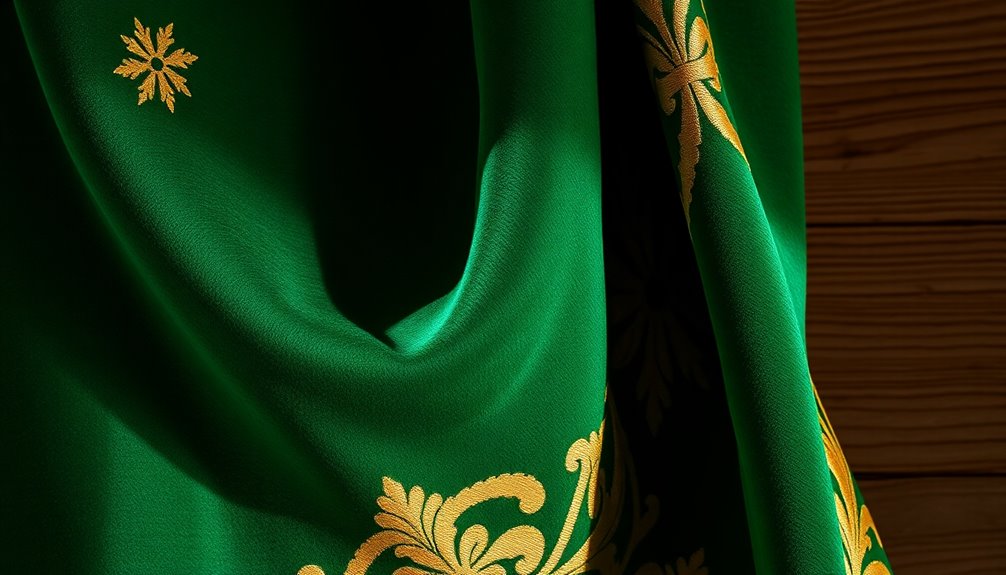
Brocade's rich history parallels that of velvet, another luxurious fabric with deep cultural roots. Velvet's origins trace back to Eastern cultures, likely China or Egypt, with evidence of its existence around 2000 BCE in Egypt and 400 BCE in China.
Early velvet-like fabrics, made from silk and linen, evolved through advanced weaving techniques in China between 400 BCE and 23 CE. As these techniques spread via the Silk Road, they significantly influenced Middle Eastern and European textile production.
During the late medieval and Renaissance periods, Italy emerged as a hub for velvet production. Cities like Venice, Florence, and Genoa became centers for skilled craftspeople, producing intricate designs commissioned by wealthy families, such as the Medici. Skilled velvet weavers thrived in Turkey, Greece, and Cyprus, contributing to the fabric's esteemed reputation.
Velvet's luxurious texture not only showcased status but also generated considerable wealth.
As velvet traveled through global trade routes, it reached various regions, including the Mamluk era in Cairo and the Ottoman Empire. By the 18th century, velvet production expanded across Europe, making it accessible to a broader audience.
Despite the rise of mass production, high-quality velvet remains a symbol of luxury, cherished for its exquisite texture and appearance.
Historical Significance of Brocade
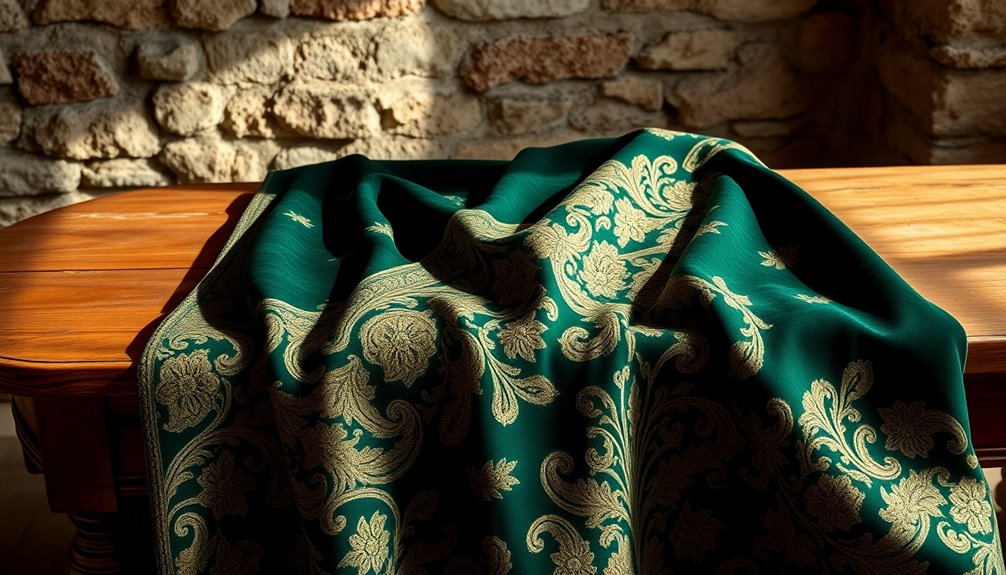
Throughout history, brocade has held a prominent place in the textile world, symbolizing luxury and power. You'll find its origins trace back to China's Warring States period, where artisans skillfully wove silk threads into intricate patterns during the Han Dynasty.
Initially, brocade was a privilege of royalty and aristocrats, its allure spreading along the Silk Road to Persia, India, and Rome. Brocade fabrics featured intricate designs and rich colors, which further enhanced their desirability among the elite.
As you explore the Middle Ages, brocade emerged as a powerful symbol of wealth in Europe, particularly from the Byzantine Empire, known for its stunning fabrics adorned with Christian iconography. Nobility and clergy donned these exquisite textiles, which often included linen and wool alongside silk.
The Italian Renaissance marked a revival, with regions like Venice and Florence embracing brocade weaving. Italian artisans introduced gold and silver threads, creating even more opulent designs influenced by Asian motifs.
This period solidified brocade's status in art and culture, making it a staple in Renaissance paintings.
While brocade production faced decline in later centuries, modern times have seen a resurgence, keeping this luxurious fabric alive in ceremonial clothing and upholstery, particularly in India.
Sustainable Fabric Trends
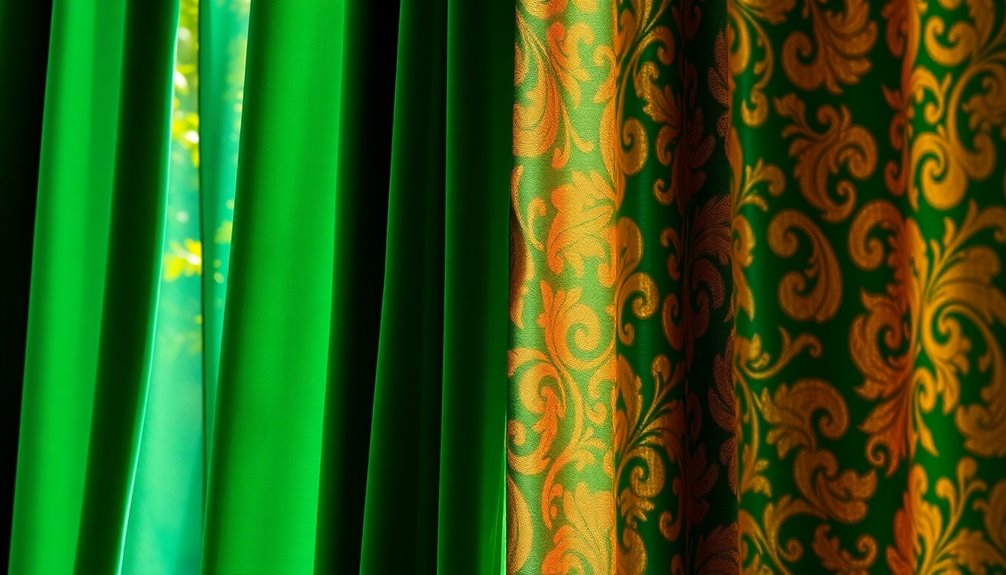
Sustainability is becoming a cornerstone in the textile industry, reshaping how fabrics like velvet and brocade are produced and consumed.
You're witnessing a shift towards using sustainable materials, with velvet now incorporating 80% BCI (Better Cotton Initiative) cotton, which minimizes water, pesticide, and fertilizer usage. Plus, many sustainable velvets include at least 20% pre-consumer recycled fibers, maintaining the luxurious look and feel you love. In particular, the Moss Green Sustainable Velvet Fabric is made from 100% recycled polyester, showcasing the industry's commitment to eco-friendly practices.
Recycled polyester is also making waves, with some velvets crafted entirely from 100% recycled materials. This commitment to eco-friendliness is reinforced by compliance with Oekotex 100, REACH, and GRS standards, ensuring safety and environmental responsibility.
Production processes are evolving too; water consumption and chemical use are significantly reduced, while energy efficiency is prioritized.
The focus on circular economy principles encourages the reuse and recycling of materials.
As demand for sustainable fabrics grows, you'll find them increasingly used in upholstery, curtains, fashion, and accessories.
With a wide array of colors and designs, these eco-friendly options not only meet your aesthetic needs but also support a healthier planet.
Look for certifications to ensure you're choosing truly sustainable options.
Choosing Eco-Friendly Textiles
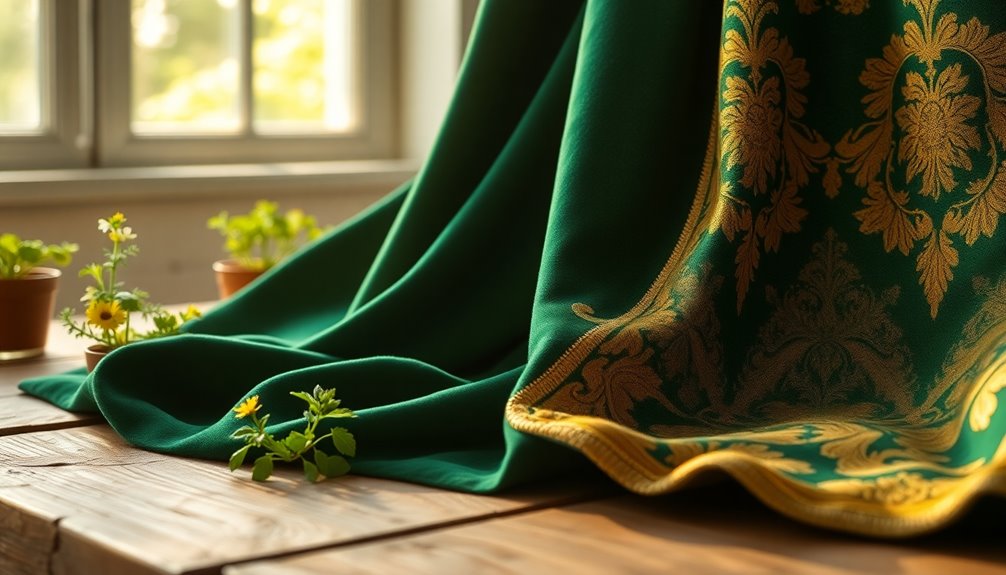
When it comes to choosing eco-friendly textiles, understanding the materials and production practices involved is essential.
Start by looking for organic cotton, which is grown without synthetic pesticides or fertilizers, minimizing environmental harm. Alternatively, consider BCI cotton, which reduces pesticide and water usage. You can also explore recycled fibers, made from post-consumer waste, to help decrease reliance on virgin resources. Mossy Oak Hand-dyed 100% Organic Cotton Velvet Fabric is an excellent example of a sustainable option that showcases beautiful craftsmanship. Additionally, selecting fabrics that align with Gold IRA fees can contribute to a more sustainable financial future.
Bamboo is another sustainable option, as it's renewable and has a lower environmental impact than traditional cotton. Upcycled materials further contribute to sustainability by repurposing existing fabrics and reducing waste.
Pay attention to production practices as well. Seek out textiles crafted using energy-efficient methods and non-toxic dyes. Water conservation during production is crucial, so look for brands that prioritize this.
Certifications like Oeko-Tex and GOTS ensure that fabrics meet safety and sustainability standards.
Lastly, choosing high-quality fabrics with a durable composition, such as blends of BCI cotton and recycled fibers, will extend the life of your textiles. This not only reduces the need for replacements but also lessens your overall environmental footprint.
Care and Maintenance of Fabrics
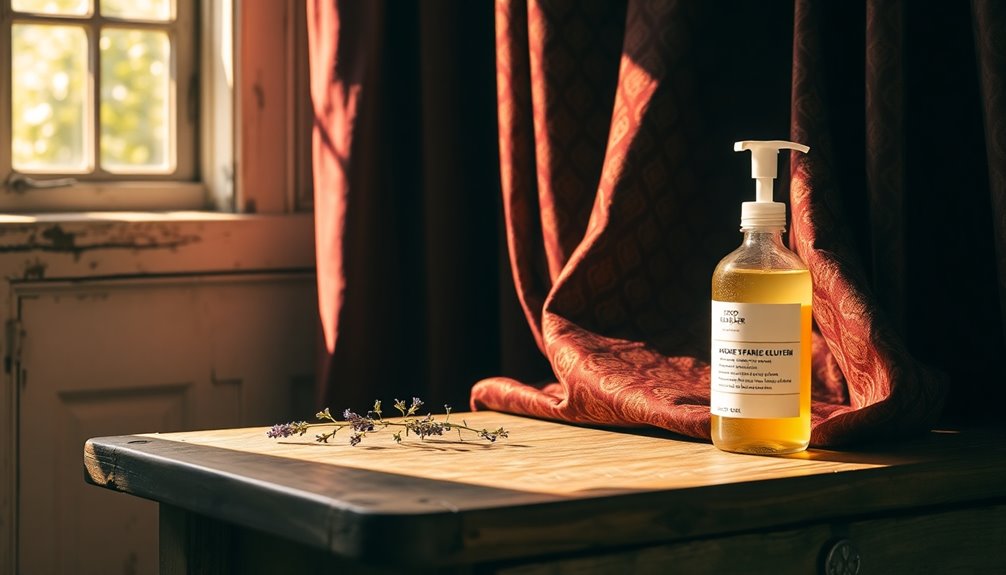
Choosing eco-friendly textiles is just the first step; proper care and maintenance ensure these fabrics remain in excellent condition for years to come.
When washing brocade, always use cold water and a gentle detergent. Avoid hot water and strong scrubbing to keep the fabric intact. For cleaning, stick to dry cleaning or spot cleaning with gentle solutions, and never use bleach. Test any cleaning products on a hidden area first. Additionally, professional dry cleaning is recommended for tough stains to prevent shrinkage or distortion.
Store your brocade in a cool, dry place, using acid-free tissue paper between garments to prevent color transfer.
For velvet, opt for mild soap and cold water for hand washing, and skip bleach and fabric softeners. Treat stains quickly and vacuum regularly using a soft brush.
When it comes to storage, use padded hangers and breathable covers to protect both fabrics. Avoid folding brocade and velvet, as it can lead to permanent creases.
Handle these fabrics delicately and keep them away from sharp objects. Regularly inspect for wear and tear, and ensure proper ventilation in storage areas to prevent mold.
Consider professional cleaning for heavily soiled pieces. Your care will enhance the longevity of these sustainable textiles.
Future of Sustainable Fashion
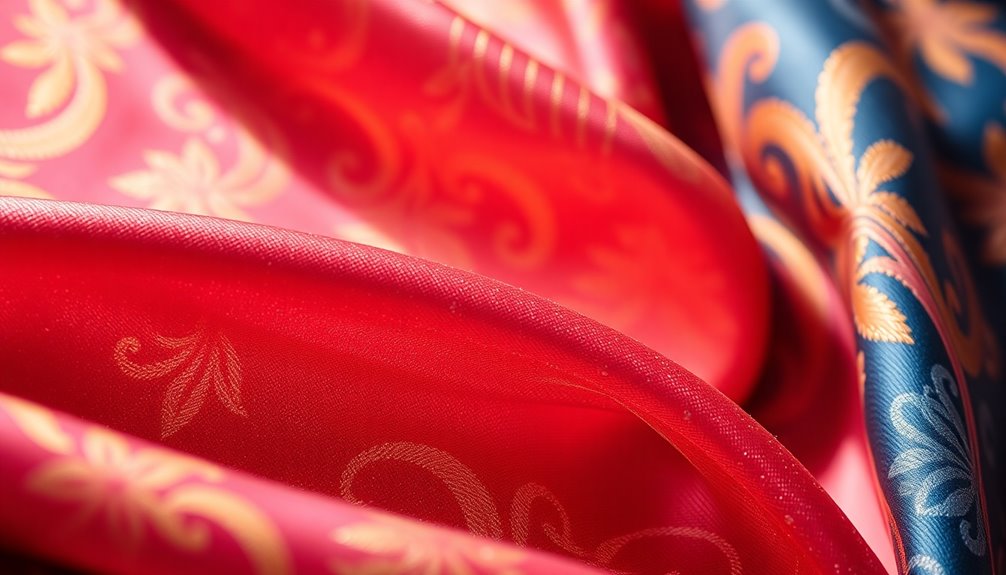
The future of sustainable fashion looks promising as more consumers demand eco-friendly options that align with their values. You're likely noticing an increase in sustainable materials like BCI cotton, which minimizes the use of pesticides and water. Brands are incorporating recycled fibers, like the 20% recycled content in Raymakers' cotton velvets, and 100% recycled polyester in sustainable velvet fabrics such as Moss. Production processes are evolving too, with adherence to ISO 14021 standards for transparency and certifications like Oekotex 100 and GRS, ensuring the fabrics you choose are responsibly made. Companies are focusing on resource efficiency, waste reduction, and sustainable dyeing techniques to create luxurious designs without compromising the environment. The incorporation of high fiber content in sustainable textiles, similar to the benefits of chia seeds, enhances the overall fabric quality. Consumer demand for eco-friendly textiles is driving more options in various shades and patterns, especially in velvets and brocade fabrics. Collaborations between brands and suppliers are becoming common, pushing for sustainable practices. Technological innovations are enhancing fabric recyclability and aesthetics, while research into alternative sustainable fibers is on the rise. You're witnessing a shift toward a sustainable fashion landscape that prioritizes both style and environmental responsibility.
Frequently Asked Questions
Can Sustainable Velvet Be Dyed Using Natural Dyes?
Yes, you can dye sustainable velvet using natural dyes. However, you'll need to consider the dye's penetration due to velvet's texture, and be prepared for potential color fading over time. It's a unique process!
What Is the Price Range for Sustainable Velvet and Brocade?
You'll find sustainable velvet and brocade prices vary widely. Expect to pay anywhere from $7 to $280 per unit, depending on quality and design. Always check different retailers to find the best fit for your budget.
Are There Certifications for Sustainable Brocade Fabrics?
Yes, there are certifications for sustainable brocade fabrics. You'll find Oeko-Tex 100 and GRS among others, ensuring safety, environmental compliance, and the use of recycled materials, making your choices more eco-friendly and responsible.
How Do I Identify Genuine Sustainable Fabrics?
To identify genuine sustainable fabrics, check for certifications like BCI, GRS, and Oekotex 100. Look for recycled materials and transparency in production processes, ensuring the fabric's environmental claims are credible and verified.
Can I Find Sustainable Velvet and Brocade in Local Stores?
You might find sustainable velvet and brocade in local stores, but options are limited. Check shops like Livingstone Textiles for sustainable velvet. Most selections are available online, so browsing retailers is your best bet.
Conclusion
In conclusion, opting for sustainable velvet and brocade not only enhances your wardrobe but also supports eco-friendly practices. By choosing these fabrics, you're making a positive impact on the environment while enjoying luxurious textures and designs. As trends shift towards sustainability, you're part of a growing movement that prioritizes the planet. So, embrace these beautiful materials, care for them properly, and help shape a brighter future for fashion. Your choices today can lead to a more sustainable tomorrow.
